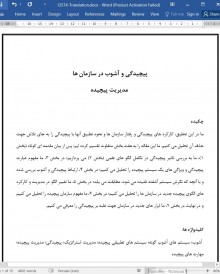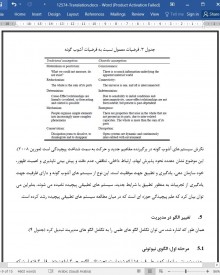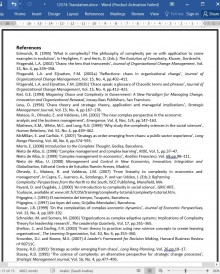
دانلود مقاله پیچیدگی و آشوب در سازمان ها: مدیریت پیچیده
چکیده
ما در این تحقیق، کارکرد های پیچیدگی و رفتار سازمان ها و نحوه تطبیق آنها با پیچیدگی را به جای تلاش جهت حذف آن تحلیل می کنیم. ما این مقاله را به هفت بخش متفاوت تقسیم کرده ایم: پس از بیان مقدمه ای کوتاه (بخش 1)، ما به بررسی تاثیر پیچیدگی در تکامل الگو های علمی (بخش 2) می پردازیم؛ در بخش 3، ما مفهوم عبارت پیچیدگی و ویژگی های یک سیستم پیچیده را تحلیل می کنیم؛ در بخش 4، ارتباط پیچیدگی و آشوب بررسی شده و با آنچه که نگرش سیستم آشفته نامیده می شود، مطابقت می یابد؛ در بخش 5، ما تغییر الگو در مدیریت و کارکرد های الگوی پیچیده جدید در سازمان ها را تحلیل می کنیم؛ در بخش 6، ما مفهوم سازمان پیچیده را تحلیل می کنیم و در نهایت در بخش 7، ما ابزار های جدید در سازمان جهت غلبه بر پیچیدگی را معرفی می کنیم.
1. مقدمه
مفهوم سازمان در طی زمان از یک مفهوم تغییر ناپذیر به یک مفهوم انعطاف پذیر تکامل یافته است. این مفهوم جدید سازمان دارای شاخص های پویای جدید همراه با تطبیق و پدیدار شدن ایده ها بوده است. لازم است تا مهارت های مدیریت و رهبری بر این محیط جدید غلبه کنند.
علم پیچیدگی در تلاش برای مطالعه، تشریح و بیان رفتار سیستم های تطبیقی پیچیده است. این علم به عنوان یک علم چند رشته ای شناخته می شود که تحت تاثیر بلوک ها (ساختارها)ی مختلف به هم مرتبط قرار گرفته است و بر اساس نظر اشنایدر و سومرز (2006)، سه بلوک ساختاری به هم مرتبط در علم پیچیدگی وجود دارند: شاخص های پویای غیر خطی، نظریه آشوب و تطبیق/تکامل. علم پیچیدگی در ارتباط با سیستم های پویای پیچیده غیر قابل پیش بینی است و موجب ارائه خصوصیات جدید و همچنین خود سازماندهی در ساختار های جدید می شود. بر اساس نظر استیسی، سازمان ها به عنوان شبکه های غیر خطی یا تعاملات انسانی محسوب می شوند که قادر به انجام رفتار های پایدار و ناپایدار هستند. سازمان های موفق در پی ایجاد محیط خلاقانه میان پایداری و ناپایداری تحت عنوان ناحیه آشفته هستند (استیسی 1993). مدیران مجبور به جستجوی تعادل نیستند بلکه باید اقدام به تغییر و ایجاد نوآوری به صورت انعطاف پذیر و تطبیقی کنند.
7. نتیجه گیری: ابزار های مدیریت پیچیده
همان طور که در بالا اشاره شد، ما باید سازمان دهی سنتی و در نتیجه مدیریت سنتی را مورد ارزیابی مجدد قرار دهیم. لازم است تا مهارت های مدیر جدید قادر به غلبه بر پیچیدگی و بهره مندی از آن به جای تلاش ناموفق جهت فرار از آن باشند.
از این رو، ابزار های مدیریت تحت شرایط پیچیدگی عبارتند از (اسنودن و بون 2007؛ اولمدو و همکاران 2007): بحث، اختلاف نظر و تنوع مطلوب جهت تشویق به ظهور الگو ها و ایده های جدید؛ تبیین موانع کلی جهت تعیین رفتار ها و نه حذف عدم قطعیت ضروری به منظور خود سازمان دهی سیستم، زیرا ممکن است کنترل اضافی موجب جلوگیری از پیشرفت احتمالات شود. ترکیب مدیریت روزانه با ساختار های مدیریتی غیر عادی و پیچیده نه تنها با استفاده از معیار های کمی بلکه با استفاده از تجربیات کیفی و بنیادین؛ تحریک خلاقیت جهت موفقیت به منظور ایجاد خلاقیت مستمر، ایجاد عدم قطعیت به صورت سنجیده جهت به کارگیری خلاقیت و نوآوری، تحریک جاذبه ها و ساختار های جدید جهت انسجام بیشتر؛ ایجاد محیط مناسب جهت بهره مندی از فرصت های غیر قابل انتظار جدید؛ در نظر گرفتن زمان برای ارتباط و واکنش؛ ایجاد ابزار های ارتباطی شفاف و ساده؛ تحریک تطبیق و انعطاف پذیری جهت جایگزین کردن مدل های نگرش کیفی کلی به منظور به کارگیری شاخص های پویای سازمانی به جای پیش بینی و کنترل و تحریک ارزش های اخلاقی در سازمان ها.
Abstract
In the present work we analyse the implications of complexity in the behaviour of organisations, and how they should adapt to this complexity instead of trying to exclude it. We divide the paper in seven different sections: after a brief introduction (Section 1) we comment the influence of complexity in the evolution of scientific paradigms (Section 2); in Section 3 we analyse the meaning of the term ‘complexity’ and the characteristics of a complex system; in Section 4 complexity and chaos are related, conforming what is named chaordic system thinking; in Section 5 we analyse the shift of paradigm in management and the implications of the new complex paradigm in organisations; in Section 6 we analyse the meaning of complex organisation; at last, in Section 7 we expose the new tools in organisation to cope with complexity.
1 Introduction
The notion or organisation has evolved along time, from a rigid state to a flexible one. This new organisation has a new dynamics, characterised by adaptation and emergence. Leadership and management skills have to evolve to cope with this new environment.
Complexity science tries to study, describe and explain the behaviour of complex adaptative systems. This is a multidisciplinary science, compounded by different interrelated blocks and, as Schneider and Somers (2006) points out, there are three inter-related building blocks of complexity science: non-linear dynamics, chaos theory and adaptation/evolution. Complexity science is concerned with complex dynamic systems which are unpredictable and, at the same time, generate new properties and spontaneously self-organise into new structures. As Stacey points out, organisations are non-linear webs or human interactions, capable of stable and unstable behaviours. The successful organisation works in the creative intermediate zone between stability and instability, the named ‘chaotic zone’ (Stacey, 1993). Managers do not have to seek equilibrium, but rather to scope with change and innovation, being flexible and adaptative.
7 Conclusions: tools for complex management
After all stated above, we have to reconsider traditional organisation and therefore traditional management too. The new manager’s skills have to be able to cope with complexity, taking advantage of it instead of unsuccessfully trying to escape.
So the tools for managing under complexity are (Snowden and Boone, 2007; Olmedo et al., 2007): favour discussion, dissent and diversity to encourage the emergence of patterns and ideas; set general barriers to delineate behaviours, not to eliminate the necessary uncertainty to let the system self-organise, because an excessive control may inhibit progress possibilities; combine common, everyday management with complex, non-ordinary management making use not only of quantitative but, also and fundamentally, qualitative experience; stimulate creativity to favour success requires continuous creativity, generating uncertainty in a deliberate way to favour creativity and innovation, stimulating attractors, emergent structures to gain coherence; create environment appropriate to take advantage of new unexpected opportunities that may emerge; allow time for communication and reflection; provide clear and easy communication tools; stimulate adaptation and flexibility, to substitute general qualitative thinking models instead to govern organisation dynamics instead of forecasting and control and stimulate ethical values in organisations.
چکیده
1. مقدمه
2. تکامل الگو های علمی
3. پیچیدگی چیست؟
3.1 ظهور و سازمان دهی خود کار، کل بزرگتر از جمع بخش های آن است.
3.1.1 سیستم های باز
3.1.2 سازگاری محدود
3.1.3 روابط تطبیقی غیر خطی
3.2 وابستگی بلند مدت، سیستم دارای یک تاریخچه است و تکامل برگشت ناپذیر است
3.2.1 عدم وجود جبرگرایی
3.2.2 ارتباط سیستم های پیچیده
4. آشوب و پیچیدگی
5. تغییر الگو در مدیریت
5.1 مرحله اول: الگوی نیوتونی
5.2 مرحله دوم: الگوی تصادفی
5.3 مرحله سوم: الگوی پیچیدگی
6. سازمان ها به عنوان سیستم های تطبیقی پیچیده
7. نتیجه گیری: ابزار های مدیریت پیچیده
منابع
Abstract
1 Introduction
2 Evolution of scientific paradigms
3 What is complexity?
3.1 Emergence and auto-organisation, the whole is greater than the sum of its parts
3.1.1 Open systems
3.1.2 Limited descomponibility
3.1.3 Non-linear adaptative relationships
3.2 Long-term dependence, the system has a history, and evolution is irreversible
3.2.1 Absence of determinism
3.2.2 Complex systems connection
4 Chaos and complexity
5 The shift of paradigm in management
5.1 First stage: Newtonian paradigm
5.2 Second stage: randomness paradigm
5.3 Third stage: complexity paradigm
6 Organisations as complex adaptive systems
7 Conclusions: tools for complex management
References
- اصل مقاله انگلیسی با فرمت ورد (word) با قابلیت ویرایش
- ترجمه فارسی مقاله با فرمت ورد (word) با قابلیت ویرایش، بدون آرم سایت ای ترجمه
- ترجمه فارسی مقاله با فرمت pdf، بدون آرم سایت ای ترجمه



